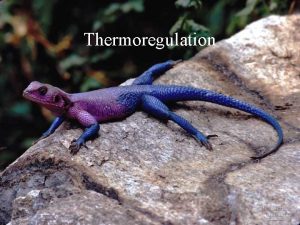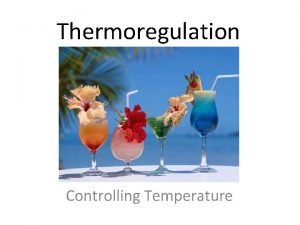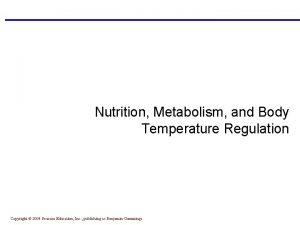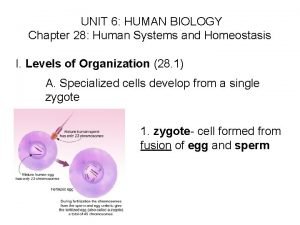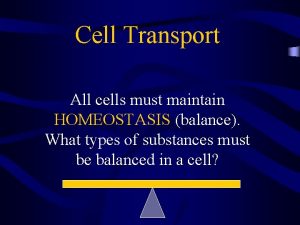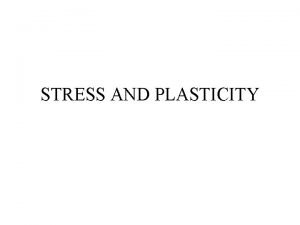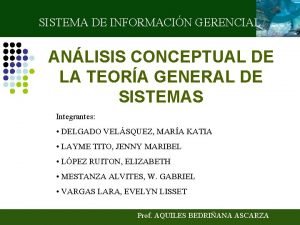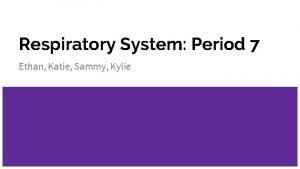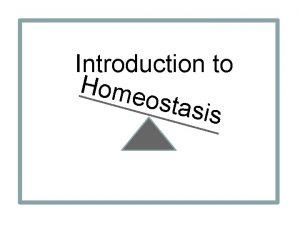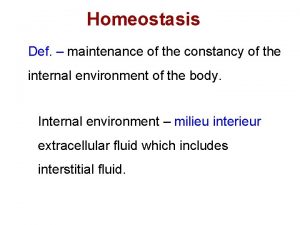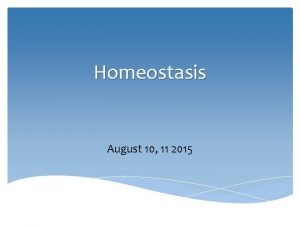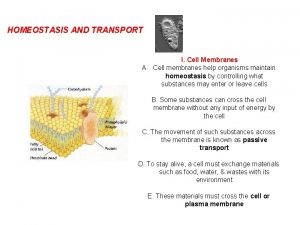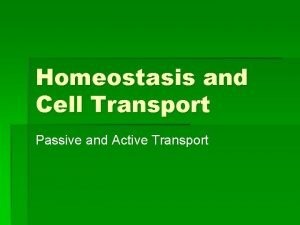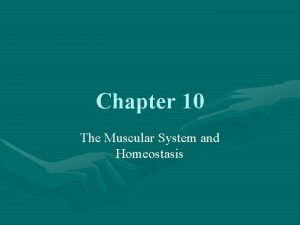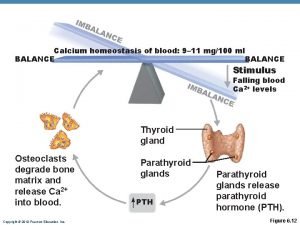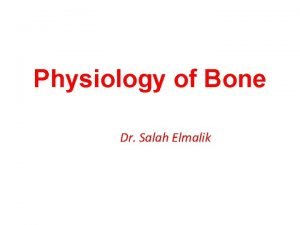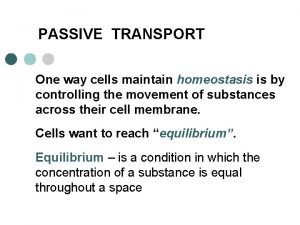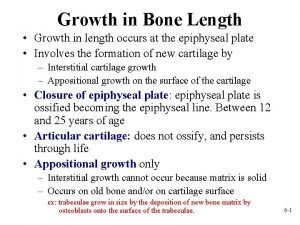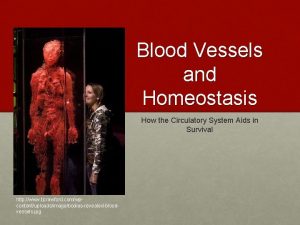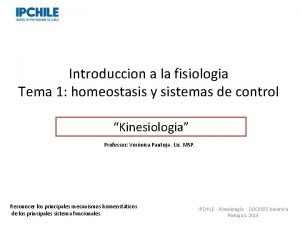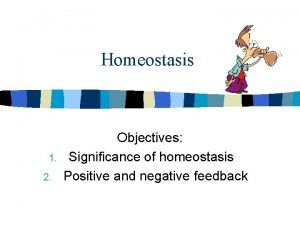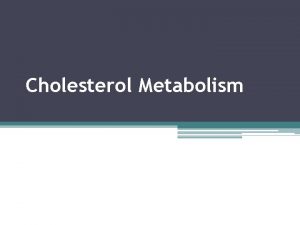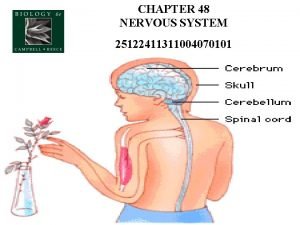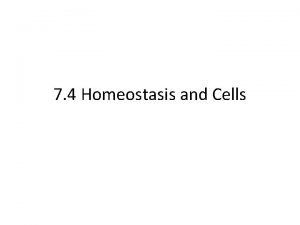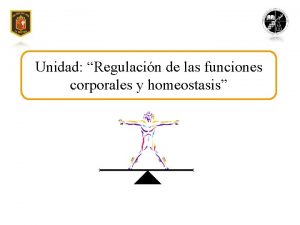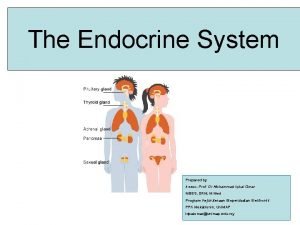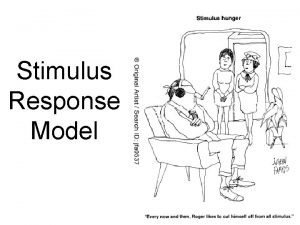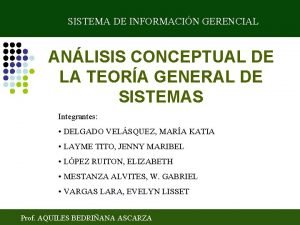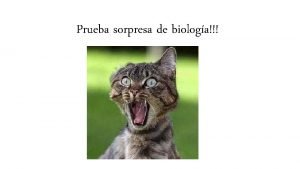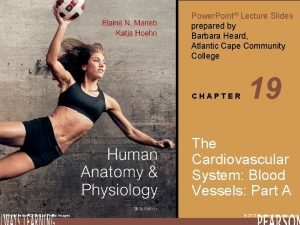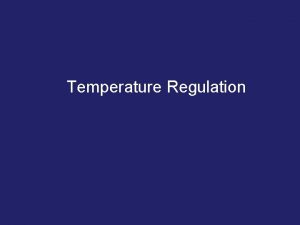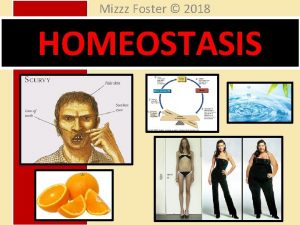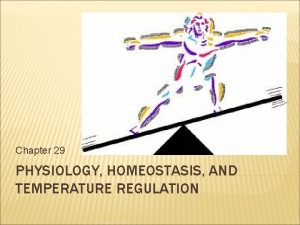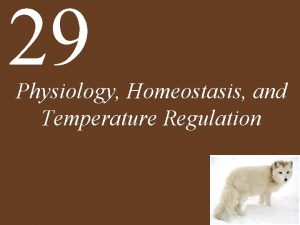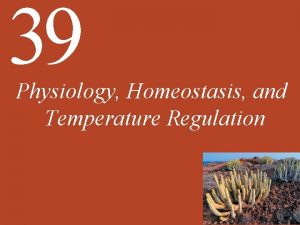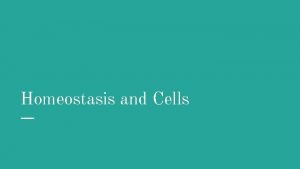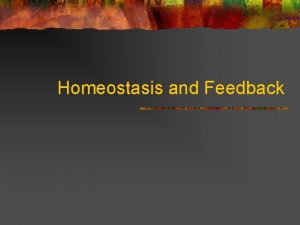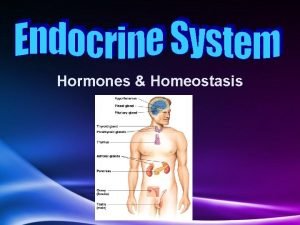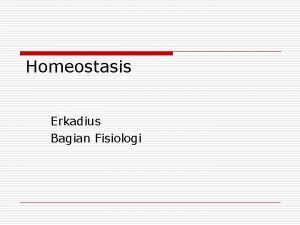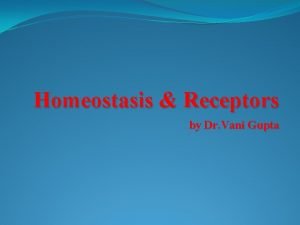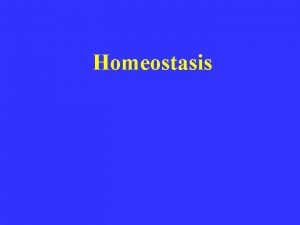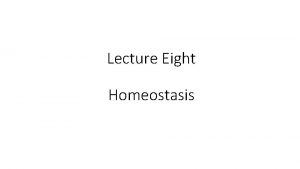41 Physiology Homeostasis and Temperature Regulation 41 Physiology
































































- Slides: 64

41 Physiology, Homeostasis, and Temperature Regulation

41 Physiology, Homeostasis, and Temperature Regulation • Homeostasis: Maintaining the Internal Environment • Tissues, Organs, and Organ Systems • Physiological Regulation and Homeostasis • Temperature and Life • Maintaining Optimal Body Temperature • Thermoregulation in Endotherms • The Vertebrate Thermostat

41 Homeostasis: Maintaining the Internal Environment • Homeostasis is the maintenance of constant conditions in the internal environment of an organism. • Single-celled organisms and simple multicellular animals meet all of their needs by direct exchange of substances with the external environment. • Simple, multicellular animal lifestyles are quite limited, however, because no part of their bodies can be more than a few cell layers thick.

41 Homeostasis: Maintaining the Internal Environment • Complex, multicellular organisms developed specialized cells that help maintain an internal environment. • The internal environment consists of extracellular fluid that bathes every cell. Cells exchange materials with this environment. • As multicellular organisms evolved, specialized cells formed specialized tissues and organs to control various aspects of the internal environment. • Homeostasis is an essential feature of complex animals.

Figure 41. 1 Maintaining Internal Stability while on the Go

41 Tissues, Organs, and Organ Systems • Cells grouped together with the same characteristics or specializations are called tissues. • The four basic types of tissue are epithelial, connective, muscle, and nervous. • An organ is composed of tissues, usually of several different types.

Figure 41. 2 Four Types of Tissue

41 Tissues, Organs, and Organ Systems • Epithelial tissues are sheets of densely packed and tightly connected cells that cover inner and outer body surfaces. • Some epithelial tissues have specialized functions: § Secretion of hormones, milk, mucus, digestive enzymes, sweat § Some have cilia to move substances. § Some epithelial cells are modified to be chemoreceptors for taste, smell, etc. § Epithelial cells may have protective, absorptive, or transport functions.

Figure 41. 3 Epithelial Tissue

41 Tissues, Organs, and Organ Systems • Epithelial tissues have distinct inner and outer surfaces. • The outer surfaces are the apical ends of the epithelial cells. They face the air (skin, lungs) or a fluid-filled organ cavity (the lumen of the gut). • Apical ends may have cilia or be highly folded to increase surface area. • The inner surfaces are the basil ends; they rest on an extracellular matrix called a basal lamina. • Some epithelial tissue, such as skin, gets much wear and tear, and thus has a high rate of cell division and replacement.

41 Tissues, Organs, and Organ Systems • Connective tissue consists of cells embedded in an extracellular matrix that they secrete. • An important component of the extracellular matrix is protein fibers. • The most common is collagen, a very strong fiber. • Collagen is very dense in tough tendons and ligaments. • It also forms a netlike framework for organs, to give shape and strength. • It has low density as loose strands when it fills in between organs.

41 Tissues, Organs, and Organ Systems • Other protein fibers include elastin which can be stretched to several times its resting length and then recoil. • Tissues that are regularly stretched, such as lung walls and artery walls, have abundant elastin.

41 Tissues, Organs, and Organ Systems • Cartilage and bone connective tissue provide rigid structural support. • Cartilage is a network of collagen fibers embedded in a flexible matrix of proteins and carbohydrates. It is found in the external ears, nose, and trachea, and lines joints of vertebrates. • The extracellular matrix of bone is hardened by the deposition of calcium phosphate.

41 Tissues, Organs, and Organ Systems • Adipose tissue is a connective tissue that forms and stores droplets of lipids. • Adipose tissue serves as a fuel reserve and as a cushion to protect internal organs. Layers of adipose tissue under the skin help insulate against heat loss. • Blood is also a connective tissue made up of cells in a fluid extracellular matrix called blood plasma. • Plasma also contains an abundance of proteins.

41 Tissues, Organs, and Organ Systems • Muscle tissues are made of elongated cells capable of contracting and causing movement by a sliding of protein filaments past each other. • They are the most abundant tissues in the body and use most of the energy the body produces.

41 Tissues, Organs, and Organ Systems • Nervous tissue is composed of neurons and glial cells. • Neurons are extremely diverse in size and form. They function by generating electrochemical signals in the form of nerve impulses. • These impulses are conducted via long extensions to other parts of the body where they communicate with other neurons, muscle cells, or secretory cells to control activities of organ systems. • Glial cells provide a number of support functions for neurons.

41 Tissues, Organs, and Organ Systems • A discrete structure that carries out a specific function in the body is an organ. Examples include the stomach and the heart. • Most organs include all four tissue types. • Most organs are part of an organ system, a group of organs that function together.

41 Physiological Regulation and Homeostasis • Homeostasis depends on the ability to regulate the functions of organs and organ systems. • Generally, the regulatory systems are the nervous system and the endocrine system. • Maintenance of homeostasis is dependent on information received, specifically feedback information that signals any discrepancy between the set point (the particular desired condition or level) and the conditions present. • The difference between the set point and the feedback information is the error signal.

Figure 41. 4 Control, Regulation, and Feedback

41 Physiological Regulation and Homeostasis • Cells, tissues, and organs are effectors that respond to commands from regulatory systems. Effectors are controlled systems. • Regulatory systems obtain, process, and integrate information, then issue commands to controlled systems, which effect change. • Regulatory systems receive information as negative feedback, which causes effectors to reduce or reverse a process; or positive feedback which tells a regulatory system to amplify a response. • Feedforward information signals the system to change the setpoint.

41 Temperature and Life • Living cells tolerate only a narrow range of temperature. Most cell function is limited to the range between 0°C and 45°C. • Even within this range, temperature change may create problems for animals. • Heat always moves from a warmer to a cooler object, so any environmental temperature change will cause change in the temperature of an organism—unless the organism can regulate its temperature.

41 Temperature and Life • Most physiological processes are temperaturesensitive, going faster at higher temperatures. • The sensitivity of a physiological process to temperature can be described as a quotient, Q 10. • Q 10 is defined as the rate of a reaction at a particular temperature (RT) divided by the rate of that reaction at a temperature 10°C lower (RT-10). Q 10 = RT / RT-10

41 Temperature and Life • Most biological Q 10 values are between 2 and 3, meaning that reaction rates double or triple as temperature increases by 10°C. • Since not all of the component reactions in an animal have the same Q 10, temperature change can disrupt physiological functioning, throwing off the balance and integration that cell processes require. • To maintain homeostasis, organisms must either compensate for or prevent temperature change.

Figure 41. 5 Q 10 and Reaction Rate

41 Temperature and Life • The body temperature of some animals is closely coupled to environmental temperature. • The animal may adjust its metabolic rate (total cell energy turnover, often measured by O 2 consumption) for different seasonal temperatures. • This process is called acclimatization, or metabolic compensation, which is a biochemical adjustment of enzyme systems to counter the effects of temperature. • The result is metabolic function that is much less sensitive to long-term temperature change than to short-term thermal fluctuations.

41 Maintaining Optimal Body Temperature • Animals may be classified by how they respond to environmental temperatures: § Homeotherms maintain a constant body temperature. § In poikilotherms, body temperature changes when environmental temperature changes. § A third category, heterotherm, fits animals that regulate body temperature at a constant level some of the time, such as hibernating mammals.

41 Maintaining Optimal Body Temperature • Animals may also be classified according to the sources of heat that determine their body temperature: § Ectotherms (most animals aside from mammals and birds) depend on external heat sources to maintain body temperature. § Endotherms (all mammals and birds) regulate body temperature by generating metabolic heat and/or preventing heat loss.

41 Maintaining Optimal Body Temperature • If a lizard (an ectotherm) and a mouse (an endotherm) are placed in a closed chamber in which the temperature is gradually raised, the body temperature of the lizard will equilibriate with that of the chamber, whereas the body temperature of the mouse will remain constant. • The metabolic rates also respond differently. In the ectotherm, metabolism decreases as air temperature decreases. • In the endotherm, metabolic rate increases as temperature decreases, which increases production of body heat.

Figure 41. 7 Ectotherms nd Endotherms (Part 1)

Figure 41. 7 Ectotherms nd Endotherms (Part 2)

41 Maintaining Optimal Body Temperature • Ectotherms such as the lizard can use behavior to regulate body temperature in the natural environment. • Behaviors include basking in the sun, seeking shade, burrowing, or orienting the body with respect to the sun. • Endotherms also use behavioral thermoregulation. Most animals select the best thermal environment whenever possible, for example by seeking shade, breezes, etc.

Figure 41. 8 An Ectotherm Uses Behavior to Regulate Its Body Temperature

Figure 41. 9 Endotherms Use Behavior to Thermoregulate

41 Maintaining Optimal Body Temperature • If the body temperature of an animal is to remain constant, the heat entering the animal must equal the heat leaving the animal. This can be expressed as an energy budget. Heatin = Heatout • Heatin = metabolism + solar radiation (Rabs) • Heatout = radiation (Rout) + convection + conduction + evaporation • If heat is entering the body through convection and/or conduction, the sign of those factors changes to negative.

Figure 41. 10 Animals Exchange Heat with the Environment

41 Maintaining Optimal Body Temperature • Any adaptation that influences the ability of an animal to deal with its thermal environment must affect one or more components of the budget. • All of the components on the right (heat-loss) side of the equation depend on the surface temperature of the animal, which can be controlled by altering the blood flow to the skin.

41 Maintaining Optimal Body Temperature • Heat exchange between the internal environment and the skin occurs largely through blood flow. • When blood is close to the surface of the skin, heat energy carried by the blood is lost to the environment by the four mechanisms listed above. • When a person is exposed to cold, blood vessels of the skin constrict, decreasing blood flow and heat transport to the skin and reducing heat loss. • Some ectotherms, such as the marine iguana, control blood flow to the skin as an adaptation for survival in cold water and hot sun.

Figure 41. 11 Some Ectotherms Regulate Blood Flow to the Skin (Part 1)

Figure 41. 11 Some Ectotherms Regulate Blood Flow to the Skin (Part 2)

41 Maintaining Optimal Body Temperature • Some ectotherms raise their body temperature by producing heat. • The flight muscles of insects must be warmed to 35– 40°C before flight can occur. This is achieved by flight muscle contractions, which generate heat in a manner similar to shivering in mammals. • Honeybees regulate temperature in a hive by group clustering to produce metabolic heat so the brood temperature stays at about 34°C even as temperatures outside of the hive drop well below freezing.

41 Maintaining Optimal Body Temperature • In most fish, blood passing through the gills comes in close contact with water, so the temperature of the blood tends to be about the same temperature as the water. • Some large fish, such as bluefin tuna and great white shark, can raise body temperature 10– 15°C above the water temperature. • In the large swimming muscles, heat is exchanged through a countercurrent heat exchanger, a structural plan that allows cool blood returning from the gills to be warmed by warm blood from the muscles.

Figure 41. 12 “Cold” and “Hot” Fish

41 Thermoregulation in Endotherms • Endotherms respond to environmental temperature change by changing rates of heat production. • Within a narrow range of temperatures, thermoneutral zone, the metabolic rate of endotherms is low and independent of temperature. • The metabolic rate of a resting animal within thermoneutral zone is called the basal metabolic rate (BMR). • The BMR of an endotherm is about six times that of an ectotherm of the same size and at the same body temperature.

41 Thermoregulation in Endotherms • Across all the endotherms, BMR per gram of tissue increases as animals get smaller. • The reason for this is unknown. • It was once thought that larger animals evolved lower metabolic rates to prevent overheating because they have low surface area–volume ratios. • However, the relationship between metabolic rate and body mass holds even for very small organisms and for ectotherms, in which overheating is not usually a problem.

Figure 41. 13 The Mouse-to-Elephant Curve (Part 1)

Figure 41. 13 The Mouse-to-Elephant Curve (Part 2)

41 Thermoregulation in Endotherms • The thermoneutral zone is bounded by a lower critical and upper critical temperature. • When environmental temperature falls below the lower critical temperature, mammals thermoregulate by generating heat (thermogenesis) through shivering and nonshivering heat production. • Birds use only the shivering mechanism. • In shivering, skeletal muscles use ATP to release only heat. Active body movement also generates heat.

Figure 41. 14 Environmental Temperature and Mammalian Metabolic Rates

41 Thermoregulation in Endotherms • Most nonshivering heat production occurs in specialized adipose tissue called brown fat. • The tissue looks brown because of its abundant mitochondria and rich blood supply. • Brown fat cells have the protein thermogenin which uncouples proton movement from ATP production, so that no ATP is produced, but heat is released. • Brown fat is commonly found in newborn infants and animals that hibernate.

Figure 41. 15 Brown Fat

41 Thermoregulation in Endotherms • The coldest environments are almost devoid of ectotherm reptiles or amphibians. • Endotherms have many adaptation for reducing heat loss in cold environments: § Reduction of surface-to-volume ratios of the body by short appendages and round body shapes § Thermal insulation by thick layers of fur, feathers, and fat. § Decreasing blood flow to the skin by constricting blood vessels, especially in appendages

Figure 41. 16 Adaptations to Hot and Cold Climates (Part 1)

Figure 41. 16 Adaptations to Hot and Cold Climates (Part 2)

41 Thermoregulation in Endotherms • In any climate, getting rid of excess heat may also be a problem, especially during exercise. • Reduction or loss of fur or hair allows for easier loss of heat from the body to the environment. • Seeking contact with water cools the skin because water absorbs heat to a greater capacity than does air. • Sweating or panting to increase evaporation provides concomitant cooling (although this benefit may be offset by water loss).

41 The Vertebrate Thermostat • The regulatory system for body temperature in vertebrates can be thought of as a thermostat. • This regulator is at the bottom of the brain in a structure called the hypothalamus. • The temperature of the hypothalamus itself is the major source of feedback information in many species. Cooling it causes fish and reptiles to seek a warmer environment, and warming it triggers the reverse behavior.

41 The Vertebrate Thermostat • In endotherms, cooling the hypothalamus causes the body temperature to rise. • Warming the hypothalamus causes dilation of blood vessels in the skin and/or sweating or panting in attempts to lower body temperature.

Figure 41. 17 The Hypothalamus Regulates Body Temperature

41 The Vertebrate Thermostat • The hypothalamus generates a set point like a setting on a thermostat. Hypothalamic temperature is a negative feedback system. • Vertebrates also integrate other sources of data, such as information from temperature sensors in the skin. • Mammals also have the ability to shift the hypothalamic set points. • The temperature of the skin can be considered feedforward information that adjusts the hypothalamic set point. • Set points are also higher during wakefulness and the active part of the daily cycle.

Figure 41. 18 Adjustable Set Points

41 The Vertebrate Thermostat • A fever is a rise in body temperature in response to pyrogens. • Exogenous pyrogens come from foreign substances such as invading bacteria or viruses. • Endogenous pyrogens are produced by cells of the immune system when they are challenged. • Pyrogens cause a rise in the hypothalamic set point, and body temperature rises until it matches the new set point.

41 The Vertebrate Thermostat • Immune system cells called macrophages attack pyrogens and release interleukins, chemicals that signal other cells and trigger other responses, including release of prostaglandins. • Interleukins also raise the hypothalamic set point. • Aspirin is an inhibitor of prostaglandin synthesis, so it lowers the set point and makes the body more comfortable. • Evidence suggests that moderate fevers help the body fight infections, but extreme fevers can be dangerous.

41 The Vertebrate Thermostat • Animals can save energy by turning down thermostat to below normal (hypothermia). • Many animals use regulated hypothermia as a means of surviving periods of cold and food scarcity. • An adaptive hypothermia called daily torpor can drop body temperature 10– 20°C and save considerable metabolic energy. • Regulated hypothermia lasting days or weeks with drops to very low temperatures is called hibernation. The reduction in metabolic rate results in enormous energy savings.

Figure 41. 19 A Ground Squirrel Enters Repeated Bouts of Hibernation during Winter

41 The Vertebrate Thermostat • Arousal from hibernation occurs when the hypothalamic set point returns to normal. • Many species of mammals hibernate, but only one bird, the poorwill, has been found to do so. • This drastic decrease of the set point probably came about as an evolutionary extension of the set point decrease that accompanies sleep in nonhibernators.
 Countercurrent exchange thermoregulation
Countercurrent exchange thermoregulation Negative feedback and body temperature regulation
Negative feedback and body temperature regulation Temperature regulation
Temperature regulation Negative feedback loop
Negative feedback loop Bioflix activity homeostasis hormones and homeostasis
Bioflix activity homeostasis hormones and homeostasis Bioflix activity homeostasis high blood glucose
Bioflix activity homeostasis high blood glucose Convection pdhpe
Convection pdhpe Difference between curie temperature and neel temperature
Difference between curie temperature and neel temperature Difference between curie temperature and neel temperature
Difference between curie temperature and neel temperature Difference between curie temperature and neel temperature
Difference between curie temperature and neel temperature Physiology of body temperature
Physiology of body temperature Chapter 28 human systems and homeostasis
Chapter 28 human systems and homeostasis Homeostasis and evolution
Homeostasis and evolution Homeostasis example
Homeostasis example Homeostasis and cell transport
Homeostasis and cell transport Drive-reduction theory
Drive-reduction theory What is allostasis
What is allostasis Mapa conceptual de homeostasis
Mapa conceptual de homeostasis Homeostasis del sistema nervioso
Homeostasis del sistema nervioso How the respiratory system maintains homeostasis
How the respiratory system maintains homeostasis Neuroadaptation addiction
Neuroadaptation addiction Homeostasis motivation
Homeostasis motivation Diferencia entre alostasis y homeostasis
Diferencia entre alostasis y homeostasis Elephant homeostasis
Elephant homeostasis Risk homeostasis
Risk homeostasis Level 3 homeostasis
Level 3 homeostasis How do cells maintain homeostasis
How do cells maintain homeostasis Def homeostasis
Def homeostasis Positive feedback blood pressure
Positive feedback blood pressure How do cells maintain homeostasis
How do cells maintain homeostasis How does diffusion help maintain homeostasis?
How does diffusion help maintain homeostasis? Ap psychology unit 8 motivation emotion and stress
Ap psychology unit 8 motivation emotion and stress Homeostasis muscular
Homeostasis muscular Irratibilidad
Irratibilidad Homeostasis blood calcium level (about 10 mg/100ml)
Homeostasis blood calcium level (about 10 mg/100ml) Homeostasis blood calcium level
Homeostasis blood calcium level Animal homeostasis
Animal homeostasis Cubital olecranal
Cubital olecranal Homeostasis worksheet
Homeostasis worksheet Homeostasis blood calcium level
Homeostasis blood calcium level Prosmosis
Prosmosis Homeostasis starter activity
Homeostasis starter activity What is maintaining an internal balance
What is maintaining an internal balance Epiphyseal cartilage
Epiphyseal cartilage Homeostasis blood calcium level
Homeostasis blood calcium level Blood vessels homeostasis
Blood vessels homeostasis Homeostasis in mammals
Homeostasis in mammals Positive vs negative feedback homeostasis
Positive vs negative feedback homeostasis Homer simpson homeostasis lab
Homer simpson homeostasis lab Give an example of homeostasis.
Give an example of homeostasis. Homeostasis y retroalimentación
Homeostasis y retroalimentación When homeostasis is disrupted
When homeostasis is disrupted Cholesterol homeostasis
Cholesterol homeostasis Cholesterol homeostasis
Cholesterol homeostasis Nervous system homeostasis
Nervous system homeostasis What do unicellular organisms do to maintain homeostasis
What do unicellular organisms do to maintain homeostasis Balancing act meaning
Balancing act meaning Sistema cerrado
Sistema cerrado Homeostasis of blood sugar
Homeostasis of blood sugar Stimulus response
Stimulus response Teleologia
Teleologia Glomerulo y capsula de bowman
Glomerulo y capsula de bowman Blood pressure homeostasis diagram
Blood pressure homeostasis diagram Hiposmotik
Hiposmotik Homeostasis psychology
Homeostasis psychology
